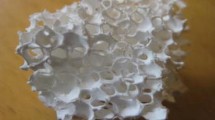Abstract
The foam separation of metal in model wastewater is performed by using two different bubble columns in a continuous operation mode. The equipment and operation conditions are changed, and the foam flow rate and metal concentration in foam flow are measured. The foam flow ratio (the ratio of foam flow rate to the inlet one) increases with increasing gas velocity, with decreasing liquid velocity, with decreasing foam layer height and with decreasing metal concentration in model wastewater. Metal enrichment (the ratio of metal concentration in foam flow to that in inlet flow) shows the reverse tendencies. When a draft tube is inserted in the bubbling layer, the foam flow rate decreases. The enrichment is strongly governed by the foam flow ratio. Since the foam flow ratio is adjusted by means of the equipment and operation conditions, the metal concentration in foam flow is controlled to be a desired value.
Similar content being viewed by others
References
Choi, S. J. and Ihm, S.K., “Removal of Cu(II) from Aqueous Solutions by the Foam Separation Techniques of Precipitate and Adsorbing Colloid Flotation,”Sep. Sci. Technol.,23, 363 (1988).
Cutting, G.W., “Effect of Froth Structure and Mobility on Plant Performance,” Mineral Processing and Extractive Metallurgy Review,5, 169 (1989).
Grieves, R. B. and Wood, R. K., “Continuous Foam Separation: the Effect of Operating Variables on Separation,”AIChE J.,10, 456 (1964).
Hiraide, M. and Mizuike, A., “Bubble Separation in Analytical Chemistry,”Bunseki,12, 902 (1984).
Kato, K. and Nakamori, I., “Adsorptive Characteristics of Ion in Foam Separation Techniques,”Kagaku Kogaku Ronbunshu,2, 272 (1976).
Kato, K., Ishikawa, T., Kasahara, Y. and Miyaki, S., “Method of Estimating Surface Excess of Metal Ion in Foam Separation,”J. Chem. Eng. Japan,25, 561 (1992).
Kubota, K., Hayashi, S. and Nishijima, M., “The Removal of Sodium and Cadmium Ions from Dilute Aqueous Solutions Using Foam Separation,”Kagaku Kogaku Ronbunshu,3, 142 (1977).
Kuze, T., Chaya, M., Yasuda, K., Bando, Y. and Nakamura, M., “Effects of Equipment and Operation Conditions on Foam Generation,” Procd. of 32th Autumn Meeting of Soc. Chem. Eng. Japan, F120 (1999).
Moussavi, M., “Foam Fractionation of Negative Ions,”Sep. Sci. Technol.,29, 1087 (1994).
Shirotsuka, T. and Ishiwata, M., “Studies on Bubble Fractionation — Adsorption Rate and Elimination of D.B.S.—,”Kagaku Kougaku,37, 397 (1973).
Suzuki, Y. and Maruyama, T., “Effects of pH and Coexistent Substances on the Foam Formation of a Protein Solution,”J. Japan Soc. Water Environment,23, 108 (2000).
Author information
Authors and Affiliations
Corresponding author
Rights and permissions
About this article
Cite this article
Bando, Y., Kuze, T., Sugimoto, T. et al. Development of bubble column for foam separation. Korean J. Chem. Eng. 17, 597–599 (2000). https://doi.org/10.1007/BF02707173
Received:
Accepted:
Issue Date:
DOI: https://doi.org/10.1007/BF02707173




